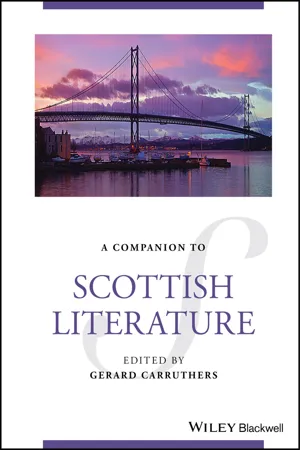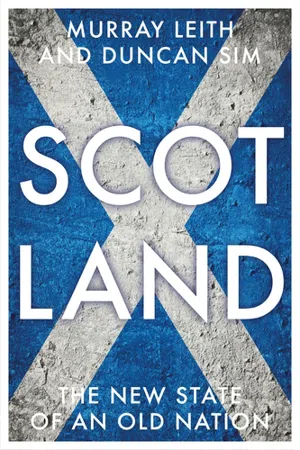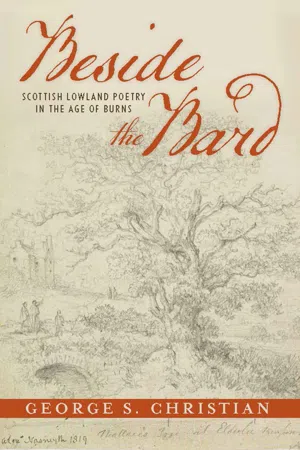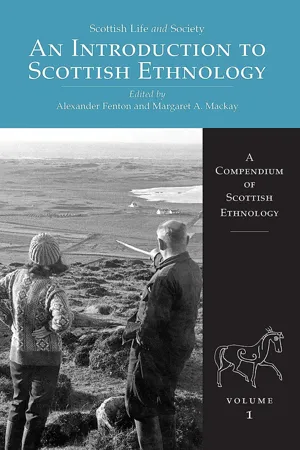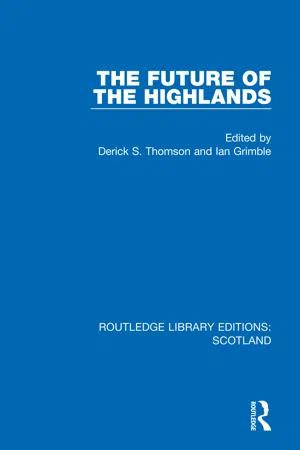Literature
Scottish Literature
Scottish literature encompasses the written and oral works produced by authors from Scotland or about Scottish themes. It includes a rich tradition of poetry, prose, and drama, with notable figures such as Robert Burns, Sir Walter Scott, and Irvine Welsh. Themes often revolve around Scottish identity, history, and landscape, reflecting the country's cultural and linguistic diversity.
Written by Perlego with AI-assistance
Related key terms
Related key terms
1 of 4
Related key terms
1 of 3
6 Key excerpts on "Scottish Literature"
- eBook - ePub
- Gerard Carruthers, Gerard Carruthers(Authors)
- 2023(Publication Date)
- Wiley-Blackwell(Publisher)
1 Introduction: What is Scottish Literature?Gerard CarruthersSchool of Critical Studies, University of Glasgow, Glasgow, ScotlandDoes Scottish Literature exist as a subject‐area and a site of scholarly enquiry? Yes. Can we completely define what Scottish Literature is in one easy, wrap‐around definition? No.As this volume suggests, something that we might categorise under the label of ‘Scottish Literature’ has been with us for nearly one and a half millennia and no doubt there were forms of creative writing in Scotland even before that. There are hundreds of authors and thousands of texts since at least the sixth century that today, in the early twenty‐first century, we might – however problematically – classify within the ‘subject’ of Scottish Literature. As an area of study with a body of texts taught in schools and universities, Scottish Literature has particularly formed a somewhat distinctive identity within ‘Literatures in English’ since the 1960s at least. Distinctive but also related, however, as in a fairly large number of universities across the world, courses in Scottish Literature are usually taught from within departments of English Studies. The post‐1960s trend saw bold subject statements with the formation of the Association for Scottish Literature in 1970 and the first and so far only discrete Department of Scottish Literature at the University of Glasgow in 1971.1 From the second part of the twentieth century critical masses of scholars in the subject‐area were to be found in other Scottish universities, and indeed – increasingly from the 1980s – in lesser number in universities in Europe, North America and the Antipodes. Less densely again but noticeably, in the twenty‐first century, Scottish Literature scholars formally researching and teaching were to be found in South America and Asia, with a large amount of activity in China from around 2010 onwards. The scholarship of Scottish Literature, then, has a firm global footprint with the International Association for the Study of Scottish Literatures (IASSL) formed in 2014.2 - eBook - ePub
Scotland
The new state of an old nation
- Murray Stewart Leith, Duncan Sim(Authors)
- 2020(Publication Date)
- Manchester University Press(Publisher)
Scotland’s relatively small size also means that those involved in the cultural and creative industries are more connected with each other and with the government. Their importance may be seen by the fact that they contribute annually almost £3 billion to the Scottish economy and employ more than 63,000 people (Archer 2014). In this chapter, we explore various aspects of Scottish culture, including literature, language, music, theatre, film and art, and we also look at the Scottish Government’s cultural policies and how they are contributing to the nation’s sense of well-being, as well as its sense of identity. Literature It is not, of course, possible in a short chapter to discuss in detail Scotland’s literary history and this is covered much more extensively elsewhere (for example Crawford 2007). For many, the country’s earliest popular literature is focused on the poems of Robert Burns in the late eighteenth century and the Waverley novels of Sir Walter Scott in the early nineteenth. Both were writing at a time when Scotland was already part of the UK yet both wrote from a very distinctive Scottish standpoint. Burns’s poems were written primarily in the Scots language and Scott’s novels often deal with aspects of Scottish history, for example the Jacobite risings, with which the British state would not have been comfortable. Yet Scott managed to be relatively ambivalent in his novels, treating Scottish history in a rather nostalgic way and presenting the rebels as heroes of a culture that had actually vanished (Gardiner 2005). During the mid-nineteenth century, however, Gardiner (2005) suggests that there was a ‘deafening silence’ in Scottish Literature with writers such as Thomas Carlyle being very Anglocentric. Only with Robert Louis Stevenson was there something of a revival, although many of his stories, such as Kidnapped and its sequel Catriona, followed Scott in embracing a rather romanticised Scottish history - eBook - ePub
Beside the Bard
Scottish Lowland Poetry in the Age of Burns
- George S. Christian(Author)
- 2020(Publication Date)
- Bucknell University Press(Publisher)
30Before turning to the poets, however, I must first establish what “Scottishness” and “Scotland” mean for purposes of this analysis. Mary Jane Scott argues that eighteenth-century Anglo-Scots poets such as James Thomson deserve to be considered as Scottish poets, rather than as exclusively English or British ones, and she recognizes this very problem of categorization: “For Scottishness is a stubborn thing. It is not simply a matter of language or locale. It takes more than a Scottish birth-certificate, or a vocabulary sprinkled with Scotticisms, to make a Scottish poet. It is all those intangible influences—religious, historical, educational, aesthetic, geographical, linguistic, literary, and broadly cultural—which work together to determine national and individual character.”31 For Scott, “Scottishness” evokes multiple bases of Scottish identity, speaking at once to the political and communal “nation” and to the ubiquitous Scottish presence in world culture. From this perspective, Scottishness constructs a kind of universal category available to anyone linked to Scotland by virtue of “broadly cultural” interpenetration. What makes Scottishness so “stubborn,” perhaps, is its refusal of signification within any standard geopolitical terminology. No one knows exactly what constitutes Scotland or Scottishness, certainly not in the way we understand the constitution of England or the United States. When Robert Crawford, for example, retails the story of Mario Vargas Llosa’s journey to Kirkcaldy and Abbotsford in search of Adam Smith and Walter Scott (citizens of the world if there ever were any), he does it to show the profound influence of Scottish Literature on the wider world, as well as the immense culture industry that nineteenth-century Scotland has produced for world consumption.32 In addition to its other presences, both concrete and evanescent, Scotland might be said to exist as a kind of corporate entity engaged in global commerce, an entity that, lacking political sovereignty, has nevertheless established a “nation” sustained by an aggressively marketed national culture. Lord Dacre may have considered this type of nationhood—tartan, pipes, and Burns night haggis feasts—as “invented” out of a collective sense of historical inferiority and loss (if not outright hucksterism), but he underestimated the capacity of Scots to “invent” a nation that allows one to “be Scottish” because one “feels” real emotional attachment to, if not affection for, his or her Scottishness.33 - eBook - ePub
An Introduction To Scottish Ethnology
A Compendium of Scottish Ethnology Volume 1
- Alexander Fenton, Margaret A. Mackay, Alexander Fenton(Authors)
- 2013(Publication Date)
- Birlinn(Publisher)
It is only possible to mention other writers whose work should be consulted for their insights into folklife and language. They include Violet Jacob (1863–1945), Marion Angus (1866–1946), George Bruce (1902–2002) and Sheena Blackhall (b.1947) from the north-east of Scotland; the Lanarkshire poet Janet Hamilton (1795–1873) for her politicised portrayals of the travails of working people’s lives; the visionary and precisely located poetry of Orcadian George Mackay Brown (1921–1996); the Edinburgh voices of Robert Garioch (1909–1981); the mountaineering culture of Andrew Greig (b.1951); and the current Scottish makar, Liz Lochhead (b.1947), for her collaborations with songwriter Michael Marra (1952–2012). Liz Niven (b.1952) celebrates the traditions of Scotland’s rural southwest. Modern ecologically engaged poets such as John Burnside (b.1955), who is worth mentioning for his fiction also, Kathleen Jamie (b.1962) and Valerie Gillies (b.1948) engage with the environment in a way that directly reflects on experiences within Scottish landscapes. In short, the topic is vast, but the writers mentioned above might prove a starting point towards a reading list.FICTIONFiction is an important source from the later eighteenth century onwards. While the novel is relatively new – early Scottish examples include the sentimental The Man of Feeling (1771) by Henry Mackenzie (17451831) and the historically driven The Scottish Chiefs (1810) by Jane Porter (17761850) it plays a vital role in transmitting traditional cultural idioms: language, practices, experiences and beliefs. For instance, the work of Susan Ferrier (17821854) Marriage (1818), The Inheritance (1824) and Destiny (1831) offers a vivid picture of the economic pressures on young, marriageable girls of a certain class, as well as of their social milieu, in her lifetime. In the nineteenth century, the relationship between orality and writing becomes particularly complex, as can be seen in a corpus dominated by the influence of Walter Scott and his coterie.24 As a whole, his work offers carefully crafted pictures of specific folk groups and folk lives at all levels. The hero of Wandering Willies Tale in Redgauntlet (1824), for instance, is a travelling fiddler with hidden depths. The antiquarian approach of Tales of a Grandfather (182830) with its vividly realised and imaginatively used portrayal of The Two Drovers, for instance, draws attention to real and perceived national and cross-border attitudinal divides, as well as to the cattle-based culture it describes. The Heart of Midlothian (1818), although historically based, reflects Scotts deep knowledge of legal culture, an aspect of many of the Waverley Novels - eBook - ePub
The Princeton Encyclopedia of Poetry and Poetics
Fourth Edition
- Stephen Cushman, Clare Cavanagh, Jahan Ramazani, Paul Rouzer, Stephen Cushman, Clare Cavanagh, Jahan Ramazani, Paul Rouzer, Stephen Cushman, Clare Cavanagh, Jahan Ramazani, Paul Rouzer(Authors)
- 2012(Publication Date)
- Princeton University Press(Publisher)
J. Hendry and R. Ross (1990); P. Bawcutt, Dunbar the Makar (1992); Iain Crichton Smith: Critical Essays, ed. C. Nicholson (1992); M. Lindsay, History of Scottish Literature, 2d ed. (1992); C. Nicholson, Poem, Purpose, Place: Shaping Identity in Modern Scottish Verse (1992); Hugh MacDiarmid: Man and Poet, ed. N. K. Gish (1993); Liz Lochhead’s Voices, ed. R. Crawford and A. Varty (1993); T. Royle, The Mainstream Companion to Scottish Literature (1993); Wood Notes Wild, Essays on the Poetry and Art of Ian Hamilton Finlay, ed. A. Finlay (1995); M. Walker, Scottish Literature since 1707 (1996); J. Corbett, Language and Scottish Literature (1997); A History of Scottish Women’s Writing, ed. D. Gifford and D. McMillan (1997); Contemporary Scottish Women Writers, ed. A. Christianson and A. Lumsden (2000); J. D. McClure, Language, Poetry and Nationhood: 1887 to the Present (2000); L. McIlvanney, Burns the Radical: Politics and Poetry in Late Eighteenth-Century Scotland (2002); Scottish Literature in English and Scots, ed. D. Gifford, S. Dunnigan, A. MacGillivray (2002); J. Sheeler and A. Lawson, Little Sparta: The Garden of Ian Hamilton Finlay (2003); Modernism and Nationalism: Source Documents for the Scottish Renaissance, ed. M. McCulloch (2004); C. White, Modern Scottish Poetry (2004); M. Fergusson, George Mackay Brown: The Life (2006); B. Kay, Scots: The Mither Tongue (2006); R. Crawford, Scotland’s Books (2007); The Edinburgh History of Scottish Literature, ed. I. Brown, 3 v. (2007); R. Watson, Literature of Scotland, 2d ed., 2 v. (2007); The Edinburgh Companion to Contemporary Scottish Poetry, ed. M. McGuire and C. Nicholson (2009); The Edinburgh Companion to Twentieth-Century Scottish Literature, ed. I. Brown and A. Riach (2009). Gaelic : See the intros. to the anthols. above; J. MacInnes, “The Panegyric Code in Gaelic Poetry and Its Historical Background,” Transactions of the Gaelic Society of Inverness 50 (1979); D. S - eBook - ePub
- Derick S. Thomson, Ian Grimble(Authors)
- 2021(Publication Date)
- Routledge(Publisher)
Literature and the ArtsDerick S. ThomsonLiterature and the Arts
The position of literature and the arts in Gaelic Scotland is affected by the structure of Gaelic society and by the society’s economic strength. Public attitudes are coloured by the religious and dogmatic principles which inform the society, or part of it. The minority status of the Gaelic language and culture has repercussions on the range and the nature of the work that is done in the various artistic media. Historical events and attitudes still exercise a profound influence on all these matters, and on the texture of life in general in the Gaelic area of Scotland, or more widely, in Scotland’s Gaelic community.Aspects of these topics have been discussed in the Introduction and in the preceding chapters, so that the reader already has in his mind many facts and opinions that will help to fill out the background to this chapter. He will know something of the historical causes of the Gaelic community’s minority status, the size and distribution of that community, the economic status of the Gaelic area, the educational pattern in the recent past and at the present time. It will already be clear that this Gaelic society is one which lacks the normal structure on which literary activity and artistic organisation are based in modern communities, although it still retains, in a fragmentary form, the archaic structure on which various kinds of artistic achievement were built in earlier times. Thus the oral literary tradition still retains some vitality, although the half-hearted way in which the educational system has come to terms with the native culture often has the effect of depriving the people of the best of both worlds.Literature and the arts need some form of patronage, however flexibly we may define ‘patronage’. At one extreme, that of truly popular generation, patronage is perhaps too well-defined a word to describe the generating impulse. Here it might be truer simply to say that literature and the arts need a public or an audience: the popular audience is the patron in this case. But in any highly organised society the artist tends to be supported directly or indirectly. He is supported directly by commissions, sales, office. But sometimes his support is largely a moral and intangible one: he is set aside from the community, and given a status or prestige which derives from his occupation. He goes about earning his living in other ways, as a civil servant or a bank clerk, and produces art in response, partly at least, to this intangible stimulus.
Index pages curate the most relevant extracts from our library of academic textbooks. They’ve been created using an in-house natural language model (NLM), each adding context and meaning to key research topics.
Explore more topic indexes
Explore more topic indexes
1 of 6
Explore more topic indexes
1 of 4
